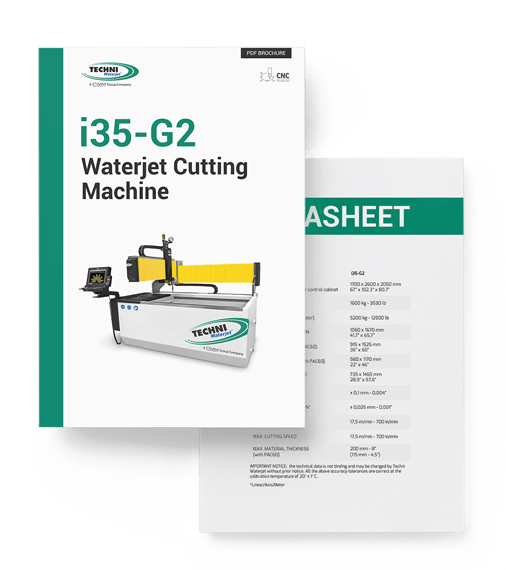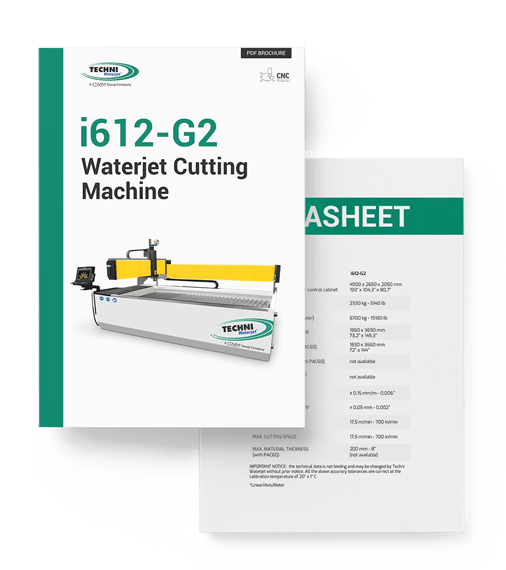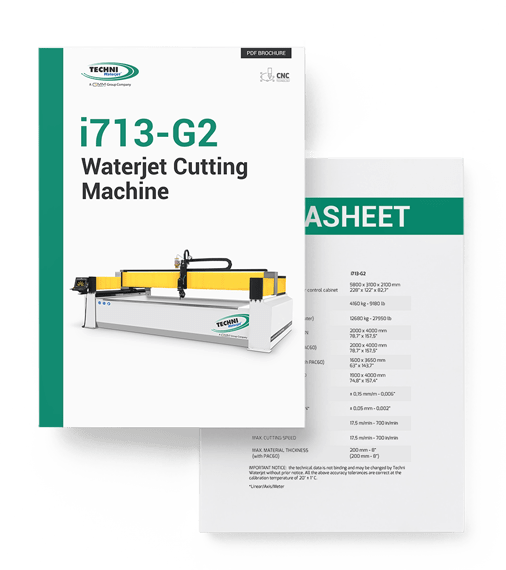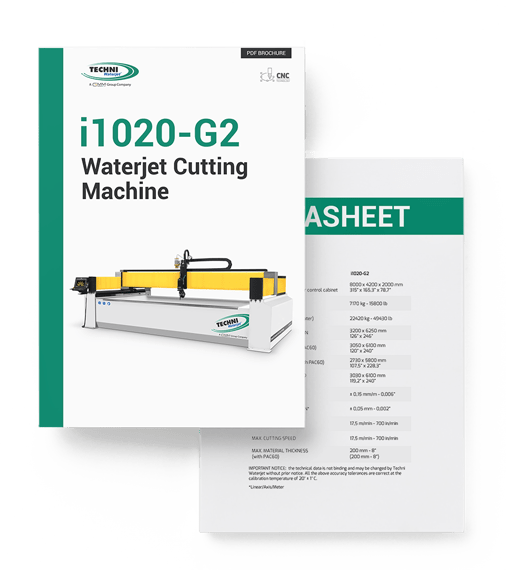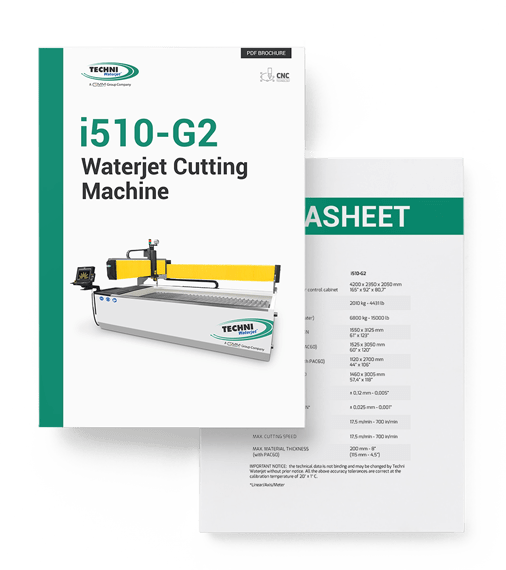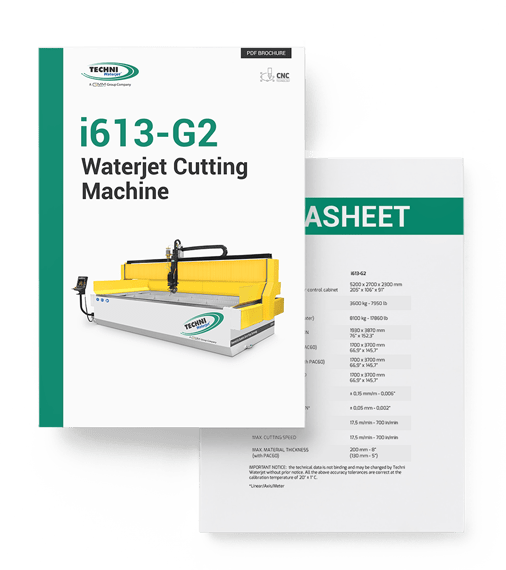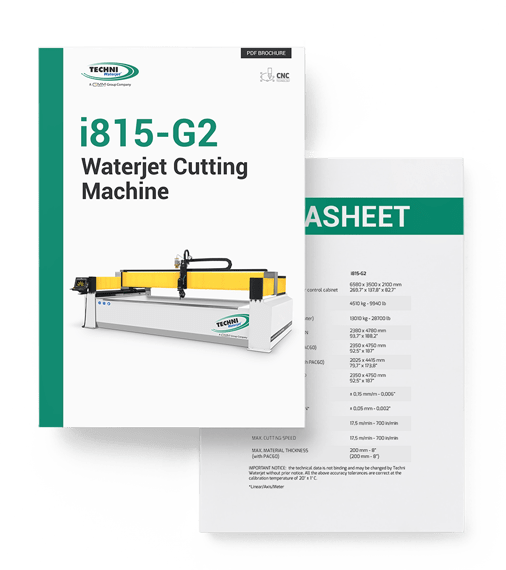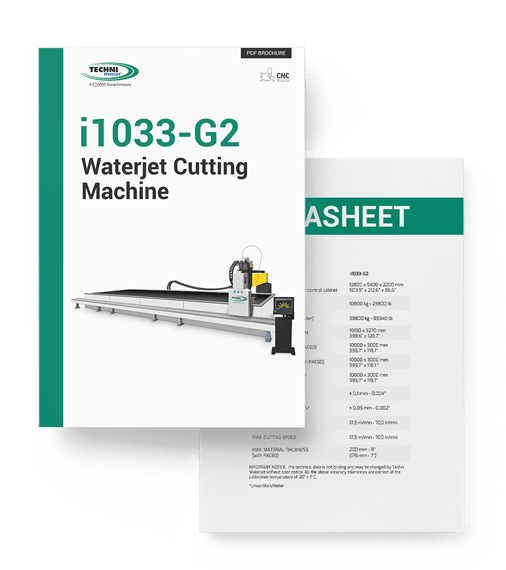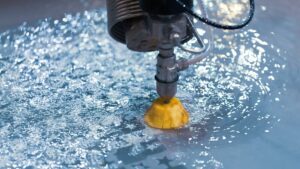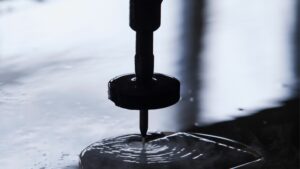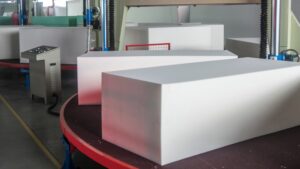Waterjet Glass Cutting | Can A Water Jet Cut Glass?
Glass is the foundation for decor, from art to architecture. Specialist glass-cutting techniques are essential for such applications.
Glass cutting is not as simple as it may sound. For one thing, glass is a delicate material and can shatter under excessive force. Additionally, it typically has sharp corners, so it requires a method that does not cause any damage to the operator.
This article will discuss waterjet glass cutting and its various benefits and applications. You will also learn many tips to improve waterjet glass cutting results.
Can You Cut Glass With a Water Jet Cutter?
Yes, cutting glass is possible with waterjet cutting. In fact, a water jet is one of the best tools for glass cutting. Waterjet glass cutting works for any type of glass. It is also possible to etch glass with a water jet.
What are the Benefits of Using a Water Jet to Cut Glass?
There are many advantages to using a water jet for cutting that make it one of the best tools for cutting glass. Below are some of these benefits.
Versatility
Waterjet cutting works for any type and thickness of glass. This factor alone is one of the main reasons for adopting waterjet cutting. Cutting glass using conventional cutting methods requires specific tools depending on the type of glass and its thickness.
Smooth & Precise Cuts
When cutting glass with a water jet, the edges are smoothly cut. This not only eliminates the risk of injury through sharp edges, but it also adds to the aesthetic appeal of the finished product. High-precision cutting makes the glass usable in intended applications without secondary finishing.
Complex Shapes
It is possible to create complex cuts in glass with waterjet glass cutting. A multi-axis water jet cutting machine is used for this purpose. These machines can make 3D cuts and etch the surface of the glass without cutting through it.
Minimal Kerfs
The water stream in waterjet cutting has a very narrow width. Due to its narrow width, the kerfs in waterjet cutting are negligible. Minimal kerf means that there is negligible wastage of material and higher accuracy.
Increased Productivity
Multiple glass panels can be placed on top of one another and cut simultaneously with waterjet cutting. This is known as stacking. It considerably increases the production speed of the process. Additionally, the parts cut using this process are identical.
Reduced Scrap
The glass removed in the waterjet cutting process can be reused. This glass dust can be separated from water easily with a mesh and reused as a fine mesh abrasive. Therefore, the wastage created in waterjet cutting is very low in volume.
Flexible Tooling
Waterjet technology works in the same manner for any type of glass. Therefore, with the same abrasive waterjet setup, you can cut ordinary glass, laminated glass, laminated ballistic glass, and other glass materials. Changing the tooling is not required even for different thicknesses of glass.
Low Operating Cost
The cost of the operations of abrasive waterjet technology is low. The main requirement is water, which is cheap and abundant. Other than that, the cost of abrasives makes up the remaining operational costs. However, since the abrasive can be reused in the following process, the operating costs remain very cheap.
Applications and Industries
Which industries are currently using water jet glass-cutting machines?
Many industries use waterjet technology; some examples include:
- Aerospace: aircraft canopies, control surfaces, prototypes, and one-of-a-kind pieces.
- Construction & Architecture: skylights, atriums, storefronts, and stained glass facades.
- Electronics: cell phone screens, computer monitors, and laboratory equipment.
- Automotive: windshields, windows, sunroofs, headlights, and rearview mirrors.
Applications of Waterjet Cutting Glass
Many other applications use cutting glass with a water jet. Here are some examples:
- Ornamental Pieces: Waterjet technology can create intricate and small glass parts due to the extremely thin waterjet cutting head nozzle and high precision. Water jet cutting is ideal for making ornamental pieces.
- High-Pressure Resistant Glass: Certain glass panels are built to resist high pressure and even explosions. Due to the thickness, most ordinary cutting methods won’t work well. Waterjet technology is an excellent option since it can cut thick glass with ease.
- Shower Doors: Glass shower doors and windows add a luxurious feel to modern bathrooms while adding a lot of utility. These doors are made using waterjet technology for smoothly cut edges and high precision.
- Mirrors: Cutting mirrors is a sensitive task since it requires special care to avoid chipping the reflective paint side. It is a cutting task best done using a waterjet brick supporting the mirror.
- Table Tops: Different types of glass-top table feature cut glass panels. Glass table-tops look elegant and are easy to clean and maintain.
- Insulated Glass: In recent years, the application of large panels of insulated glass on buildings has become common. These panels can keep indoor areas thermally insulated from the outdoors.
Tips for Cutting Glass With a Water Jet Cutter
It is easy to cut glass with a high-pressure water jet, and the process does not require a high level of expertise. However, certain tips can improve the quality of the cut and produce smoother results.
Fixturing: When cutting glass on a waterjet cutting table, it is vital to have an adequate support surface under the glass. This is typically achieved using a waterjet brick, which is soft enough for the waterjet stream to pass through without bouncing back on the glass being cut.
Quality of Abrasive: The quality of the abrasive material can significantly improve the cut quality. Using finer abrasive material eliminates microchipping of the edges along the cut.
Sagging: A long abrasive line can cause sagging of the abrasive, leading to the possibility of the glass cracking. Reducing the abrasive line can eliminate sagging, create a better abrasive flow and prevent cracking.
Cutting Mode: High-end waterjet cutters, such as those provided by Techni Waterjet, come with complimentary software. This software contains various cutting modes, allowing users to choose the best cutting mode for brittle material like glass.
Water Pressure Control: Waterjet technology uses water at very high pressure. However, when cutting glass using an abrasive waterjet, start with a low pump pressure and increase it slowly. This is because the abrasive flow rate is quite slow initially, so the water pressure should be proportional to this flow rate for cutting consistency.
Lead-in: When cutting glass with a water jet, it is a good idea to have a long lead-in if possible. A long lead-in ensures that if a crack emerges during the first piercing, it does not enter the edge of the final part.
Temperature Shifts: Sudden shifts in temperature can cause an ordinary glass sheet to break. For instance, if it is taken out of a hot water tank and comes into contact with cold air or cold water from a hose, it can result in the glass panel shattering.
Factors to Consider When Choosing a Water Jet Cutter
A water jet can be an expensive investment. Therefore, evaluating different cutters on key factors can be beneficial to make sure that you make a cost-effective decision.
- Cutting Axis: The cutting axis is the freedom of movement of a water jet machine. The higher the number of axes, the higher the complexity of parts that can be made with the cutter. Multi-axis cutters (four or more cutting axis) significantly increase the cost of the machine.
- Water Pressure: Water jet cutting is all about using high-pressure water to remove the material from the workpiece. The pressure determines the capability of the waterjet machine. Therefore, the cutter you choose should have sufficient pressure to cut glass of the thickness required.
- Software Compatibility: Modern waterjets function without much human intervention. Instead, they use compatible software. Ideally, the software should come bundled with the waterjet cutter, with common cut shapes preloaded.
- Budget: The price range of water jet cutters is vast. Therefore, set a budget you can spend on a machine and then browse through the various waterjet machines within that price range.
Recommended Machine For Glass Cutting
Techni Waterjet is one of the most reliable water jet manufacturers, providing a range of cutters with various features and functionality. Its machines are often lauded by industry experts due to their high value for money. They perform excellently in all the factors mentioned, regardless of the material thickness.
These machines come with complimentary software that contains preloaded cutting shapes you commonly require. Additionally, the extended warranty reflects the manufacturer’s faith in the build quality of its water jets.
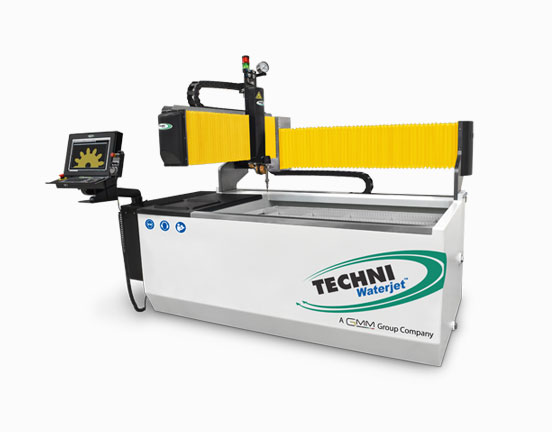
i35-G2
Waterjet Cutting
Machine
| Machine Size | 1700L x 2600W x 2050H mm |
| Cutting Table Size | 936 x 1576 mm |
| Machine Type | Cantilever |
| Accuracy of Motion (Linear/Axis/Meter) | 0.1mm - 0.004" |
| Max Material Thickness | 200mm - 8" |
| Materials that can be Cut | Listed here |
| Price | Enquire for Price |
| Brochure | Download |
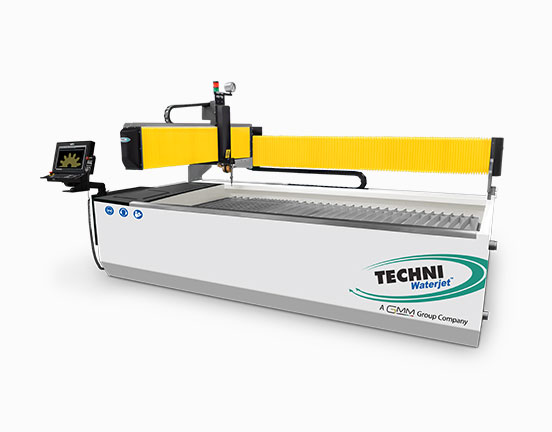
i612-G2
Waterjet Cutting
Machine
| Machine Size | 4900L x 2650W x 2050H mm |
| Cutting Table Size | 1860 x 3690 mm |
| Machine Type | Cantilever |
| Accuracy of Motion (Linear/Axis/Meter) | ±0.15 mm - 0.006" |
| Max Material Thickness | 200mm - 8" |
| Materials that can be Cut | Listed here |
| Price | Enquire for Price |
| Brochure | Download |
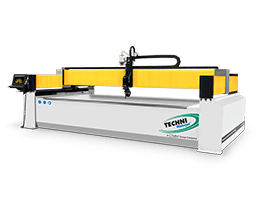
i713-G2
Waterjet Cutting
Machine
| Machine Size | 5800L x 3100W x 2100H mm |
| Cutting Table Size | 2000 x 4000 mm |
| Machine Type | Gantry |
| Accuracy of Motion (Linear/Axis/Meter) | ±0.15 mm - 0.006" |
| Max Material Thickness | 200mm - 8" |
| Materials that can be Cut | Listed here |
| Price | Enquire for Price |
| Brochure | Download |

i1020-G2
Waterjet Cutting
Machine
| Machine Size | 8000L x 4200W x 2000H mm |
| Cutting Table Size | 3200 x 6250 mm |
| Machine Type | Gantry |
| Accuracy of Motion (Linear/Axis/Meter) | ±0.15 mm - 0.006" |
| Max Material Thickness | 200mm - 8" |
| Materials that can be Cut | Listed here |
| Price | Enquire for Price |
| Brochure | Download |

i510-G2
Waterjet Cutting
Machine
| Machine Size | 4200L x 2350W x 2050H mm |
| Cutting Table Size | 1550 x 3125 mm |
| Machine Type | Cantilever |
| Accuracy of Motion (Linear/Axis/Meter) | ±0.12 mm - 0.005" |
| Max Material Thickness | 200mm - 8" |
| Materials that can be Cut | Listed here |
| Price | Enquire for Price |
| Brochure | Download |
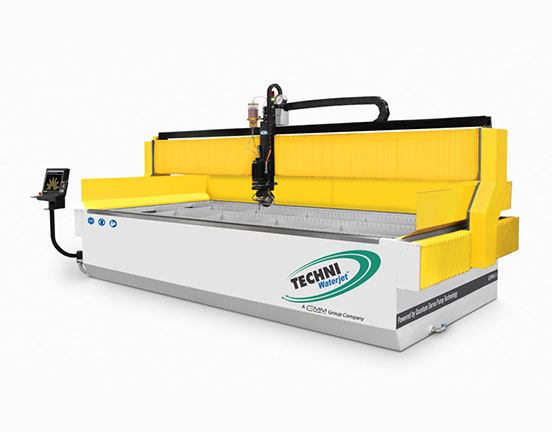
i613-G2
Waterjet Cutting
Machine
| Machine Size | 5200L x 2700W x 2300H mm |
| Cutting Table Size | 1930 x 3870 mm |
| Machine Type | Monoblock |
| Accuracy of Motion (Linear/Axis/Meter) | ±0.15 mm - 0.006" |
| Max Material Thickness | 130mm - 5" |
| Materials that can be Cut | Listed here |
| Price | Enquire for Price |
| Brochure | Download |

i815-G2
Waterjet Cutting
Machine
| Machine Size | 6580L x 3500W x 2100H mm |
| Cutting Table Size | 2380 x 4780 mm |
| Machine Type | Gantry |
| Accuracy of Motion (Linear/Axis/Meter) | ±0.15 mm - 0.006" |
| Max Material Thickness | 200mm - 8" |
| Materials that can be Cut | Listed here |
| Price | Enquire for Price |
| Brochure | Download |
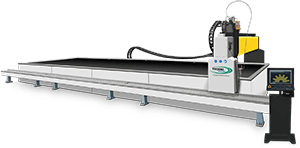
i1033-G2
Waterjet Cutting
Machine
| Machine Size | 12800 x 5400 x 2200 mm |
| Cutting Table Size | 10150 x 3270 mm 399.6” x 128.7” |
| Machine Type | Gantry |
| Accuracy of Motion (Linear/Axis/Meter) | ± 0.1 mm - 0.004” |
| Max Material Thickness | 200mm - 8" |
| Materials that can be Cut | Listed here |
| Price | Enquire for Price |
| Brochure | Download |
Is a Waterjet the Best Solution for Cutting Glass?
Yes, waterjet cutting is undoubtedly the best glass cutting method. There is no other method that provides the benefits and scalability of waterjet glass cutting while retaining a pinpoint accuracy in the process.
Conclusion
Regardless of the type of glass, waterjet cutting is the go-to choice for glass machining. In fact, the process is extendable beyond glass and can also be used on any other soft or hard material. For this reason alone, waterjet machines are being adopted across all industries involving metal, wood, glass, plastics, and more.
Therefore, if you are in need of an industrial cutting machine for metal, glass, or any other material, do give waterjet cutters a try. For more information, browse through the vast catalogue of high-end cutters provided by Techni Waterjet.
Frequently Asked Questions
Here are the answers to some common concerns regarding waterjet cutter
Can you cut stained glass with a water jet cutter?
Yes, waterjet cutting can be easily applied to stained glass of any thickness and dimensions.
Can you cut tempered glass with a water jet cutting machine?
No, it is not possible to cut tempered glass with a water jet cutting machine. Tempered glass is an exception for waterjet cutting, since this type of glass is designed to shatter into pieces whenever it is punctured.
Can you cut laminated glass with a water jet cutting machine?
Yes, water jet cutting machine can cut through laminated glass. In fact, the hardest variety of this glass, such as laminated ballistic glass material, can also be cut with a water jet.
Can waterjet cut bulletproof glass?
Yes, water jet machines can cut through bulletproof glass.
Can waterjet cut strengthened glass?
Yes, the waterjet can easily cut strengthened glass material at a high speed with an abrasive of higher mesh sizes.
Can a waterjet cut float glass?
Yes. A water jet can cut float glass without any risk of it shattering.
Can waterjet cut thin glass?
Yes, the waterjet can cut thin glass with ease. In fact, waterjet cutting is one of the best methods for thin glass since other alternatives can cause the thin glass material to break.
What glass can't be cut by a water jet glass cutter?
Among all materials, only tempered glass cannot be cut with a water jet cutter. This is because tempered glass is designed to shatter upon impact or puncture.

